
USS Winnebago was one of four monitors employed by Rear Admiral David Glasgow Farragut in the Battle of Mobile Bay. Their mission was to facilitate the entry of his squadron into the bay by bombarding Fort Morgan, which controlled the bay's entrance, and engaging the Confederate ironclad Tennessee if she tried to interfere. Winnebago was the third ship in the line of monitors. Though her turrets were frozen in train by broken mechanisms, her crew had man-handled them around to the starboard broadside, and she was able help in suppressing Fort Morgan's resistance with shot and shell, and with a shroud of dense gunsmoke that largely concealed the Union ships as they steamed past.
During the engagement with CSS Tennessee shortly after Farragut's ships had entered Mobile Bay, Winnebago played a supporting role. Since her turret troubles prevented her from engaging closely, she remained at a moderate distance from the enemy ship, training her guns on it by maneuvering her own hull and firing as the guns came on target.
This page features all our views of USS Winnebago during
the Battle of Mobile Bay, 5 August 1864.
Note that many of these pictures inaccurately depict Winnebago's
aspect during the the engagement with CSS Tennessee.
For other images of USS Winnebago, see:
| If you want higher resolution reproductions than the digital images presented here, see: "How to Obtain Photographic Reproductions." |
Click on the small photograph to prompt a larger view of the same image.
|
Photo #: NH 42396 "Battle of Mobile Bay ... Passing Fort Morgan and the Torpedoes" Print after an artwork by J.O. Davidson, 1886, depicting the Union and Confederate squadrons at the moment that USS Tecumseh sank after striking a mine ("torpedo"). Confederate ships (left foreground) are Morgan, Gaines and Tennessee. Union monitors visible astern of Tecumseh are Manhattan and Winnebago. USS Brooklyn is leading the outer line of Union warships, immediately followed by USS Hartford. Courtesy of President Franklin D. Roosevelt, 1936. U.S. Naval Historical Center Photograph. Online Image: 81KB; 740 x 525 pixels |
 |
|
Photo #: NH 42392 "Battle of Mobile Bay, August 5, 1864" Reproduction of an 1864 pen & ink drawing by George S. Waterman, C.S.N., depicting the action as seen from above and inside the entrance to Mobile Bay. Confederate ships present are (as identified on the drawing): Selma, Morgan, Gaines (shown twice, in the battle line, and beached off Fort Morgan after the battle) and Tennessee. Union monitors shown are (from the front of the line): Tecumseh (sinking after striking a mine), Manhattan, Winnebago and Chickasaw. The leading two steam sloops in the Union line are Brooklyn and Hartford. Small diagram in the lower right represents the various efforts by Union ships to ram the Tennessee later in the action. U.S. Naval Historical Center Photograph. Online Image: 150KB; 740 x 580 pixels |
 |
|
Photo #: NH 2377 Battle of Mobile Bay, 5 August 1864 USS Monongahela rams CSS Tennessee as other Union warships move into position to engage. The two twin-turret monitors depicted at the right are USS Winnebago and USS Chickasaw. Civil War vintage artwork, photographed by T. Lilienthal, New Orleans, Louisiana. Courtesy of the Philibrick Collection, Kittery, Maine. U.S. Naval Historical Center Photograph. Online Image: 77KB; 740 x 495 pixels |
 |
|
Photo #: NH 1055 "The 'Tennessee' at Bay, in the Battle of Mobile Bay", 5 August 1864 Halftone reproduction of a Currier & Ives lithograph, published in "Admiral Franklin Buchanan, Fearless Man of Action", by Charles Lee Lewis. The original lithograph was provided by Mr. Franklin Buchanan Owen. Another copy is reportedly held by the Library of Congress. This view depicts, none too accurately, the CSS Tennessee in the center at the time she surrendered, surrounded by the Union warships. The latter include (at right) the twin-turret monitors Chickasaw and Winnebago at right. One of the single-turret monitors would be Manhattan. There was no second single-turret monitor present at this stage of the battle. The large ship in the left foreground is presumably USS Hartford. Fort Morgan is shown in the right distance, but much closer to the action than was actually the case. U.S. Naval Historical Center Photograph. Online Image: 99KB; 740 x 405 pixels |
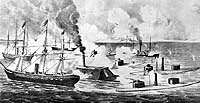 |
|
Photo #: NH 1678 Battle of Mobile Bay, 5 August 1864 CSS Tennessee surrounded by Union warships, near the end of the battle. The two twin-turret monitors depicted off her bow and stern are USS Winnebago and USS Chickasaw. Civil War vintage artwork, photographed by T. Lilienthal, New Orleans, Louisiana. Courtesy of the Philibrick Collection, Kittery, Maine. U.S. Naval Historical Center Photograph. Online Image: 97KB; 740 x 515 pixels |
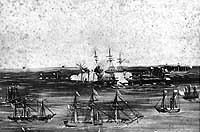 |
|
Photo #: NH 42395 "Surrender of Ram Tennessee" Photograph of a sketch by 3rd Assistant Engineer Robert Weir, of USS Richmond. It depicts the CSS Tennessee surrounded by U.S. Navy warships at the conclusion of the Battle of Mobile Bay, 5 August 1864. Ship in the left foreground is USS Hartford. Twin-turret monitors at right are USS Chickasaw and USS Winnebago. U.S. Naval Historical Center Photograph. Online Image: 79KB; 740 x 320 pixels |
 |
|
Photo #: KN-843 (Color) Battle of Mobile Bay, 5 August 1864 Oil on canvas (40" x 66") by Xanthus Smith (1839-1929), signed and dated by the artist, 1890. It depicts the surrender of CSS Tennessee to the Union squadron commanded by Rear Admiral David G. Farragut. Identifiable U.S. Navy ships present include: Winnebago (monitor in the left distance), Chickasaw (monitor in the foreground) and Hartford (Farragut's flagship, in the right center, painted light gray). Courtesy of the U.S. Naval Academy Museum, Annapolis, Maryland. Gift of Henry Huddleston Rogers, 1930. Official U.S. Navy Photograph. Online Image: 67KB; 740 x 470 pixels Reproductions of this image may also be available through the National Archives photographic reproduction system as Photo # 428-KN-843 |
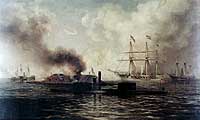 |
|
Photo #: NH 1276 Battle of Mobile Bay, 5 August 1864 Line engraving after an artwork by J.O. Davidson, published in "Battles and Leaders of the Civil War", Volume 4, page 378. Entitled "Surrender of the 'Tennessee,' Battle of Mobile Bay", it depicts CSS Tennessee in the center foreground, surrounded by the Union warships (from left to right): Lackawanna, Winnebago, Ossipee, Brooklyn, Itasca, Richmond, Hartford and Chickasaw. Fort Morgan is shown in the right distance. U.S. Naval Historical Center Photograph. Online Image: 179KB; 740 x 540 pixels |
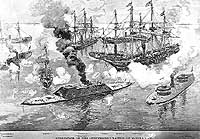 |
|
Photo #: NH 42394 "Capture of the Confederate ram Tennessee" Artwork by J.O. Davidson, depicting the surrender of CSS Tennessee at the conclusion of the Battle of Mobile Bay, 5 August 1864. U.S. Navy ships depicted include monitor Winnebago and sloop Monongahela, in the left background; sloop Ossipee "in collision with Tennessee", in center; monitor Chickasaw "lying across the stern of Tennessee", in right foreground; gunboat Itaska, in right distance; and flagship Hartford further to the right. U.S. Naval Historical Center Photograph. Online Image: 85KB; 740 x 410 pixels |
 |
|
Photo #: NH 42393 Battle of Mobile Bay, August 5, 1864 Photograph of sketches by 3rd Assistant Engineer Robert Weir, of USS Richmond, that were presented by him to Captain Thornton Jenkins. The top sketch depicts the Union steam sloops Richmond, Hartford and Brooklyn on "The Day before the Battle Aug. 4th ...". Sketch plan at bottom depicts the Union "Fleet Anchored" within Mobile Bay after passing Fort Morgan. Ships represented include Hartford, Brooklyn and Richmond plus the monitors Chickasaw and Winnebago. U.S. Naval Historical Center Photograph. Online Image: 94KB; 740 x 505 pixels |
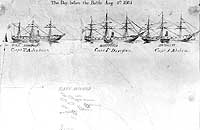 |
|
Photo #: NH 83136 "Entrance of Rear Admiral Farragut in to Mobile Bay. August 5th 1864" Chart of the action, prepared by RAdm. D.G. Farragut, Washington, D.C., March 1st, 1865. See Photo # NH 83136 (complete caption) for further information, as printed on the original chart. Courtesy of the Naval Historical Foundation. U.S. Naval Historical Center Photograph. Online Image: 277KB; 870 x 1200 pixels |
 |
For other images of USS Winnebago, see:
| If you want higher resolution reproductions than the digital images presented here, see: "How to Obtain Photographic Reproductions." |
New images added 16 September 2000